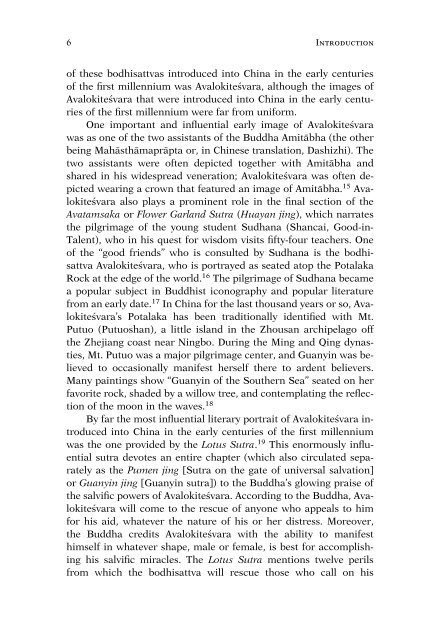Two Precious Scroll Narratives of Guanyin and Her ... - Khamkoo
Two Precious Scroll Narratives of Guanyin and Her ... - Khamkoo
Two Precious Scroll Narratives of Guanyin and Her ... - Khamkoo
You also want an ePaper? Increase the reach of your titles
YUMPU automatically turns print PDFs into web optimized ePapers that Google loves.
6 Introduction<br />
<strong>of</strong> these bodhisattvas introduced into China in the early centuries<br />
<strong>of</strong> the first millennium was Avalokiteśvara, although the images <strong>of</strong><br />
Avalokiteśvara that were introduced into China in the early centuries<br />
<strong>of</strong> the first millennium were far from uniform.<br />
One important <strong>and</strong> influential early image <strong>of</strong> Avalokiteśvara<br />
was as one <strong>of</strong> the two assistants <strong>of</strong> the Buddha Amitābha (the other<br />
being Mahāsthāmaprāpta or, in Chinese translation, Dashizhi). The<br />
two assistants were <strong>of</strong>ten depicted together with Amitābha <strong>and</strong><br />
shared in his widespread veneration; Avalokiteśvara was <strong>of</strong>ten depicted<br />
wearing a crown that featured an image <strong>of</strong> Amitābha. 15 Avalokiteśvara<br />
also plays a prominent role in the final section <strong>of</strong> the<br />
Avatamsaka or Flower Garl<strong>and</strong> Sutra (Huayan jing), which narrates<br />
the pilgrimage <strong>of</strong> the young student Sudhana (Shancai, Good-in-<br />
Talent), who in his quest for wisdom visits fifty-four teachers. One<br />
<strong>of</strong> the ‘‘good friends’’ who is consulted by Sudhana is the bodhisattva<br />
Avalokiteśvara, who is portrayed as seated atop the Potalaka<br />
Rock at the edge <strong>of</strong> the world. 16 The pilgrimage <strong>of</strong> Sudhana became<br />
a popular subject in Buddhist iconography <strong>and</strong> popular literature<br />
from an early date. 17 In China for the last thous<strong>and</strong> years or so, Avalokiteśvara’s<br />
Potalaka has been traditionally identified with Mt.<br />
Putuo (Putuoshan), a little isl<strong>and</strong> in the Zhousan archipelago <strong>of</strong>f<br />
the Zhejiang coast near Ningbo. During the Ming <strong>and</strong> Qing dynasties,<br />
Mt. Putuo was a major pilgrimage center, <strong>and</strong> <strong>Guanyin</strong> was believed<br />
to occasionally manifest herself there to ardent believers.<br />
Many paintings show ‘‘<strong>Guanyin</strong> <strong>of</strong> the Southern Sea’’ seated on her<br />
favorite rock, shaded by a willow tree, <strong>and</strong> contemplating the reflection<br />
<strong>of</strong> the moon in the waves. 18<br />
By far the most influential literary portrait <strong>of</strong> Avalokiteśvara introduced<br />
into China in the early centuries <strong>of</strong> the first millennium<br />
was the one provided by the Lotus Sutra. 19 This enormously influential<br />
sutra devotes an entire chapter (which also circulated separately<br />
as the Pumen jing [Sutra on the gate <strong>of</strong> universal salvation]<br />
or <strong>Guanyin</strong> jing [<strong>Guanyin</strong> sutra]) to the Buddha’s glowing praise <strong>of</strong><br />
the salvific powers <strong>of</strong> Avalokiteśvara. According to the Buddha, Avalokiteśvara<br />
will come to the rescue <strong>of</strong> anyone who appeals to him<br />
for his aid, whatever the nature <strong>of</strong> his or her distress. Moreover,<br />
the Buddha credits Avalokiteśvara with the ability to manifest<br />
himself in whatever shape, male or female, is best for accomplishing<br />
his salvific miracles. The Lotus Sutra mentions twelve perils<br />
from which the bodhisattva will rescue those who call on his

















